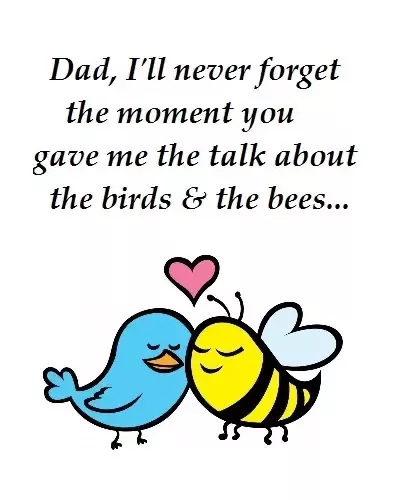The Wholesome Approach to Explaining the Birds and the Bees
Hello, wonderful parents and guardians! Are you preparing to navigate the sometimes awkward but incredibly important waters of discussing the “birds and the bees” with your beloved child? Fear not! You are about to embark on a beautifully natural teaching moment, and we’re here to help make this experience as smooth and as positive as possible. ???
In this comprehensive guide, we’ll offer you insightful tips and age-appropriate language to explain the wonders of human reproduction, emotional relationships, and respect for oneself and others. Let’s shed light on the topic and create a nurturing environment where your kids feel safe and comfortable to explore their curiosity.
Understanding the Basis: What Does “The Birds and the Bees” Really Mean?
Before diving into the conversation, it’s essential to grasp the meaning behind the terms “the birds and the bees.” Traditionally, this phrase represents the gentle and metaphorical explanations of the facts of life, specifically focusing on reproduction and the natural processes leading to the creation of life. It’s a charming, less intimidating way to introduce children to a complex topic.
Knowing the Right Time: When Should You Have ‘The Talk’?
The “perfect” time to talk about the birds and the bees varies from one child to another. It’s all about keenly observing and recognizing when they’re showing signs of curiosity about where babies come from or expressing interest in body changes—commonly around the ages of 3 to 5 for the basics and more detailed discussions in the pre-teen years. However, let your child’s questions guide you; it’s always the right time to provide age-appropriate answers to their queries.
Preparation: How to Set the Scene for a Healthy Discussion
Setting the right tone is crucial. Opt for a comfortable and quiet space, free from distractions, where you both feel at ease to talk. It’s not just about the biological facts. It’s equally about conveying values, emotions, and respect surrounding the topic.
Here are a few steps to ease you into the conversation:
- Do your homework: Arm yourself with the correct information. Brushing up on the basics ensures you’re providing accurate knowledge and are ready to answer any surprise questions your child might have.
- Stay positive: Approach the conversation with a smile and let your child know that this is a natural, wonderful part of life and nothing to be embarrassed about.
- Use books or visuals: Sometimes, a good book or illustration can make explaining the mechanics of reproduction, anatomy, and relationships much easier to grasp for young minds.
- Encourage questions: Make sure they understand that all questions are good questions, promoting an open dialogue.
This dialogue is not a one-off talk; think of it as an ongoing conversation that will evolve as your child grows and develops.
Breaking the Ice: Initiating the Conversation with Clarity and Confidence
Starting the conversation can seem daunting, but it’s all about simplicity and clarity. Begin with what they know and build from there. Acknowledge the natural world first, discussing how animals reproduce, and then draw parallels to humans in a clear, understandable manner.
For younger children, you may want to start by explaining the process of a seed growing into a plant and then relate it to animals and people. Older children might be ready for more direct explanations and can handle more nuanced discussions about emotions and relationships.
Remember to use the correct anatomical terms for body parts—this will help demystify the subject and set a factual basis for the conversation. Instill a sense of normalcy and avoid conveying any sense of taboo around the topics of sex and reproduction.
Dear parents, as we wrap up this first segment of your jovial journey into explaining the birds and the bees, remember to be patient, listen actively, and validate your child’s feelings. Open communication is key. Stay tuned for more detailed discussions on talking points, age-appropriate responses, and how to handle different reactions from kids!
This is just the beginning of a lifelong conversation that will help your children understand their bodies, their feelings, and their relationships with others, empowering them to make informed, respectful choices throughout their lives. With open hearts and minds, we’ll continue nurturing their knowledge and your connection. Let’s keep the chat joyful, honest, and full of love!

Five Tips for Parents Preparing for “The Talk” about the Birds and the Bees
Speaking of beginnings, let’s highlight five essential tips to prepare you for this meaningful journey:
1. Embrace the Journey of Learning Together
Recognize that this is a journey for both you and your child. Learning together about life’s processes can be a bonding experience. Accept that you may not have all the answers, and that’s perfectly okay! This openness paves the way for a joint exploration of knowledge, leading to mutual growth and understanding.
2. Adapt the Conversation to Your Child’s Developmental Stage
Children absorb information differently at various developmental stages. Tailor your conversation to suit your child’s level of understanding. Keep explanations simple for younger children, using analogies they are familiar with, while older children may require more detailed and direct information.
3. Be Mindful of Your Language and Attitude
The words and attitudes you present during these discussions will form the foundation of your child’s perceptions. Avoid using euphemisms that might confuse. Instead, respect their intelligence and curiosity by using proper terminology and a respectful, open attitude. This helps establish a healthy dialogue about sexuality and relationships.
4. Encourage Ongoing Communication
Ensure your child knows that this isn’t just a one-time talk, but an ongoing conversation where they can always feel comfortable coming to you with their questions. Circumvent the pressure of a “big reveal” by discussing sexuality as an evolving topic over time.
5. Highlight the Importance of Consent and Respect
It’s crucial to go beyond the biological aspects and talk about consent, respect, and the emotional components of relationships. This helps in building a perspective that values oneself and others, which is vital in today’s world.
The birds and the bees talk is more than a singular discussion; it’s a series of conversations that adapt and grow with your child’s curiosity and understanding. Embrace it as an opportunity to instill values and knowledge that will support their well-being for years to come. With each talk, you’re helping to shape a future adult who respects themselves and the world around them. Isn’t that an amazing role to play?
As they grow, so will their questions, and that’s a sign of a healthy, inquiring mind. Your role as a parent is to steadily guide them through their inquiry with honesty, openness, and love. Keep the conversations flowing, and the subjects at hand won’t feel so daunting—for you or for them!
Moreover, weaving in stories from the natural world about the diversity of life and reproductive strategies (like those found among birds and bees) can help highlight the beauty of diversity in human relationships too. It’s a fantastic way to celebrate both the unity and the uniqueness of life itself. So, tighten those seatbelts, and don’t forget to enjoy the ride on this fantastic journey of shared discovery!
The topics you cover today will serve as the stepping stones for your child’s emotional intelligence and responsible decision-making tomorrow. Together, you’ll navigate this uncharted world—one heart-to-heart at a time. Thank you, dear parents, for taking on this essential role with grace and dedication. Your children—and the future they will help to shape—are indeed bright, thanks to your loving guidance!
See more great Things to Do with Kids in New Zealand here. For more information see here
Disclaimer
The articles available via our website provide general information only and we strongly urge readers to exercise caution and conduct their own thorough research and fact-checking. The information presented should not be taken as absolute truth, and, to the maximum extent permitted by law, we will not be held liable for any inaccuracies or errors in the content. It is essential for individuals to independently verify and validate the information before making any decisions or taking any actions based on the articles.




